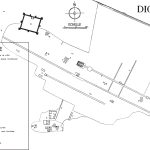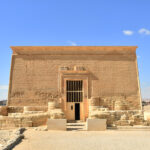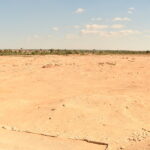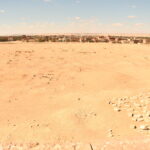QAṢR QĀRŪN (DIONYSIAS)
| Egyptian | Pȝ-dmỉ-n-mȝy | Pȝ-dmỉ-mȝy |
| Greek | Διονυσιάς |
| Latin | Dionisias |
| Arabic | قصر قارون |
| English | Dionysias | Qasr Qarûn | Kesr Keroun |
| French | Qasr Qaroun |
| DEChriM ID | 50 |
| Trismegistos GeoID | 565 |
| Pleiades ID | 736904 | PAThs ID | 119 |
| Ancient name | Dionysias |
| Modern name | Qaṣr Qārūn |
| Latitude | 29.406230 |
| Longitude | 30.420885 |
| Date from | -229 |
| Date to | 640 |
| Typology | Village |
| Dating criteria | Papyrological documentation (the three archives of Flavius Abbinaeus, Gemellus, and Heroninus) and six fragmentary inscriptions (Römer 2019: 277-279). The earliest document related to Dionysias is P.LilleDem. 110, dated to 229/228 BCE, in which the village is called “the new village”. The latest, dated to 640-699, is P.Laur. III 93 (TM 37305), which contains references to village heads (μείζονες) of a village called Dionysias, possibly the same location. The latter document is the only late attestation for this part of the Fayyūm. |
| Description | The site of Dionysias is situated in the western end of the Fayyūm, 3.5km from the salt-lake of Birkat Qārūn, the modern remnants of the ancient Moeris Lake. The site is also known as Qaṣr Qārūn, which is the name of a modern village located nearby. The town was founded in the Ptolemaic period and is understood to have been occupied up until the sixth century. Only a limited number of buildings are preserved to a height greater than a meter and a half, greatly limiting understandings of the urban planning of the site (Davoli 1998: 301). As of 2009, the Dionysias Archaeological Project, directed by Emanuele Papi, has helped to resolve this, with remote sensing technology assisting in mapping the settlement. The features recognisable on the ground include a stone kiosk, a brick building thought to have been a Roman mausoleum and a thermal-like structure (Schwartz, 1950: 6). The most renowned features of the settlement, however, are a Ptolemaic temple dedicated to the crocodile god Sobek and a Roman fort built under the Tetrarchy which housed, according to the Notitia Dignitatum, the ala quinta praelectorum (Schwartz et al. 1969: 85, fig. 1; O’Connell, 2018: 488; P. Flor. I, 30, 5-6). |
| Archaeological research | Unlike other sites in the Fayyūm, Dionysias received relatively limited attention by early explorers and archaeologists. A number of travelers visited the site between the 18th and 19th centuries, specifically the temple, including N. Granger, P. Lucas, R. Pococke, G. B. Belzoni, G. Schweinfurth and K. R. Lepsius (see Cestari, 2010: 19-32 for a more detailed history). The first ‘scientific’ exploration was by members of Napoleon’s scientific team, particularly Jomard, who provided a description and drawings of the temple (Jomard, 1821: 437-527). Grenfell and Hunt visited the site briefly in 1898-1899, where they searched in vain for papyri. It is not known specifically where they searched (Grenfell, Hunt and Hogarth, 1900: 63). The only actual archaeological excavations to have taken place so far were those of a joint Franco-Swiss mission (University of Geneva and the Institut français d’archéologie orientale) in 1948 and 1950, led by J. Schwartz and H. Wild. As can be expected, the excavators did not prioritise stratigraphy. Restoration work of the Roman temple was carried out by Ibrahīm ʿAbd al-ʿAzīz and Ṭaha al-Šiltawī on behalf of the Service of Antiquities in 1957 (Davoli, 1998: 309; Leclant, 1961: 176). The Supreme Council of Antiquities is understood to have conducted some excavations, but nothing is known, let alone published. In 2009, the University of Siena initiated work for the Dionysias Archaeological Project, directed by Emanuele Papi. The project, which had campaigns in 2009, 2010 and 2012, utilised various non-invasive methods, including remote sensing technologies, topographical, magnetic and geophysical surveys, so as to develop a more comprehensive understanding of the developmental progression of the urban plan of the site, particularly in light of Greco-Roman influence. This project enabled a detailed reconstruction of the settlement, with some 16 hectares prospected. In an area between the fortress and the temple, at the northern limit of the settlement, hundreds of terracotta moulds were found totaling to some 15000, used for the casting of coins (Schwartz, 1950: 39-48). These moulds have recently become the focus of an IFAO project led by P. -M. Guihard, J. Chameroy and G. Blanchet. |
• Abdelaal, S., J.-M. Vallet, J. Bethonneau, G. Mhagoub and E. Ali. 2014. “Degradation of Engraved Stone and Renders from Qasr Qarun Temple in Fayoum Oasis, Egypt.” In Proceedings of the International Conference on Conservation of Stone and Earthen Architectural Heritage 2014, ICOMOS-ISCS International Conference. 171-180. Gongju: The Graduate School of Cultural heritage Kongju National University.
• Audebeau, C. 1917. “Les toitures du temple de Kasr-el-Karoun. La ville détruite environnant le sanctuaire et le lac Karoun.” Bulletin de l’Institut d’Égypte 11: 171-194.
• Belzoni, G. B. 1988. Viaggi in Egitto ed in Nubia, edited by A. Siliotti. Firenze: Arte e Natura libri.
• Bigi, L. 2015. “La produzione di olio nel Fayyum di età romana: le nuove richerche dell’Università di Siena a Dionysias (Qasr Qarun, Fayyum – Egitto).” In Archeologi in Progress: il cantiere dell’archeologia di domani, edited by R. Brancato, G. Busacca and M. Massimino, 233-244. Bologna: BraDypUS Editore.
• Brouwers, K. 2010. “Flavius Abinnaeus and His Ala V Praelectorum. A Study of Cultural Contact at the 4th Century Auxiliary-Fortress of Dionysias, Egypt.” Unpublished M.A. Dissertation, Leiden University.
• Camporeale, S. 2011. “Methods for the Study of the Building Techniques and the “Built Environment”: The Example of Dionysias.” In Natural and Cultural Landscapes in the Fayoum. The Safeguarding and Management of Archaeological Sites and Natural Environments. Proceedings of the International Colloquium 31st October – 2nd November 2010, edited by R. Pirelli, 95-105. Cairo: Unesco.
• Carpentiero, G. 2016. “Continuity and Change in Hellenistic Town Planning in Fayum (Egypt): Between Tradition and Innovation.” In De Africa Romaque: Merging Cultures Across North Africa, edited by N. Mugnai, J. Nikolaus and N. Ray, 73-83. London: Society for Libyran Studies.
• Carpentiero, G. And C. Tessaro. 2016. “Multi-Scale Approach for the Reconstruction of a Past Urban Environment. From Remote Sensing to Space Syntax: The case of Dionysias (Fayum, Egypt).” In CAA2015 Keep the Revolution Going. Proceedings of the 43rd Annual Conference on Computer Applications and Quantative Methods in Archaeology Vol I., edited by S. Campana, R. Scopigno, G. Carpentiero and M. Cirillo, 803-814. Oxford: Archaeopress Publishing.
• Carrié, J.-M. 1974. “Les Castra Dionysiados et l’évolution de l’architecture militaire romaine tardive.” Mélanges de l’École française de Rome 86/2: 819-850.
• Cavenaile, R. 1969. “Dionysias-les-Mines (Fayoum).” Studia Papyrologica 8: 7-35.
• Cestari, I. 2010. Villaggi dell’antico Egitto 3. Dionysias. Imola: La Mandragora.
• Chameroy, J. 2009. “Münzgussformen und Münzreformen in Ägypten am Anfang des 4. Jahrunderts n. Chr.” Jahrbuch für Numismatik und Geldgeschichte 59: 101-125.
• Chameroy, J. and P.-M. Guihard. 2014. “L’officine de faux-monnayeurs de La Coulonche (Orne): nummi coulés de la Tétrarchie en Occident.” Numismatic Chronicle 174: 153-191.
• D’Anville, J. B. 1766. Mémoires sur l’Égypte ancienne et moderne, suivis d’une description du Golfe Arabique et de la mer Rouge. Paris: Imprimerie Royale.
• Davoli, P. 1998. L’archeologia urbana nel Fayyum di età ellenistica e romana. p. 301-311. Napoli: G. Procaccini.
• Davoli, P. and M. Faisal. 2020. “Stone Archetypes for Inlay Molds and Molded Gypsum Case from Dionysias/Qasr Qarun Temple.” Studi di egittologia e di papirologia 17: 75-95.
• De Cenival, F. 1980. “Compte de céréales de plusieurs villages du Fayoum: P.Dém.Lille 110 (Inv. Sorbonne 205 à 213).” In Livre du centenaire (1880-1980), edited by J. Vercoutter. 193-203. Cairo: Institut français d’archéologie orientale.
• Gad, U. 2010. “The Village of Dionysias in the Arsinoite Nome from the First to the Fourth Century A.D. in Light of Greek Papyri.” Unpublished M.A. Dissertation, Ain Shams University.
• Granger, N. 1745. Relation du voyage fait en Égypte par le sieur Granger, en l’année 1730. Paris: Jacques Vincent.
• Grenfell, B. P., A. S. Hunt and D. G. Hogarth. 1900. Fayûm Towns and Their Papyri. London: Offices of the Egypt Exploration Fund.
• Grossmann, P. 1995. “Ein spätantikes Mausoleum in Qaṣr Qarūn-Dionysias.” Bulletin de la Société d’archéologie copte 34: 139-148.
• Guihard, P.-M. 2019. “La fausse monnaie coulée au début du IVe siècle dans la vallée du Nile (Égypte). État de la question.” In Money Matters: Coin Finds and Ancient Coin Use, edited by S. Krmnicek and J. Chameroy, 83-100. Bonn: Habelt Verlag.
• Guihard, P.-M., J. Chameroy and G. Blanchet. 2019a. “Les moules monétaires de Qasr Qarun/Dionysias: contrefaire la monnaie dans la vallée du Nil au début du IVe siècle.” Supplément au Bulletin de l’Institut français d’archéologie orientale 119: 58-62.
• Guihard, P.-M., J. Chameroy and G. Blanchet. 2019b. “Un atelier de faux-monnayeurs en Égypte romaine.” Archeologia 582: 48-53.
• Hamouda, F. E. 2019. “Τὰ χαλκωρύχια, the Copper Mines in the Area of Dionysias.” In The Fayoum Survey Project. The Themistou Meris. Vol A: The Archaeological and Papyrological Survey, edited by C. E. Römer, 259-260. Leuven, Paris, Bristol: Peeters.
• Jomard, E. 1821. “Description des antiquités du nome Arsinoite, aujourd’hui le Fayoum.” In Description de l’Égypte ou Recueil des observations et des recherches qui ont été faites en Egypte pendant l’expédition de l’armée française, IV, 437-527. Paris: C. L. F. Panckoucke.
• Karelin, D., T. Zhitpeleva and M. Karelina. 2015. “Imaging of the Late Roman Castrum – 3: 3D Reconstruction of the Late Roman Fortress at Dionysias in Egypt.” Architecture and Modern Information Technologies 1 (30): 1-25.
• Lepsius, K. R. 1849. Denkmaeler aus Aegypten und Aethiopien nach den Zeichnungen der von Seiner Majestät dem Koenige von Preussen, Friedrich Wilhelm IV., nach diesen Ländern gesendeten, und in den Jahren 1842-1845 ausgefürten wissenschaftlichen Expedition auf Befehl Seiner Majestät II. Berlin: Nicolaische Buchhandlung.
• Lucas, P. 1714. Voyage du sieur Paul Lucas, fait par ordre du Roy dans la Grece, l’Asie Mineure, la Mecedoine et l’Afrique, II, 40-58, 63-71. Paris: Nicolas Simart.
• Lucas, P. 1719. Troisième voyage du sieur Paul Lucas, fait en 1714, par ordre de Louis XIV dans la Turquie, l’Asie, la Syrie, la Palestine, la Haute et Basse-Égypte, etc., 253-296. Rouen: Robert Machuel le jeune.
• Martin, M. 1987. “Un tour du lac Qarūn en 1717.” Bulletin de l’Institut français d’archéologie orientale 87: 265-268.
• Noeske, H.-C. 2001. Spätkaiserzeitliche Münzgußformen aus dem Fayum (aus dem Nachlaß F. Zucker). In Erinnerungen an einen Rektor: Friedrich Zucker (1881-1973), edited by H. G. Walther, 63-88. Jena: Hain.
• O’Connell, E. R. 2018. “Dionysias.” In The Oxford Dictionary of Late Antiquity, vol. I A-I, edited by O. Nicholson, 488. Oxford: Oxford University Press.
• Papi, E., L. Bigi, S. Camporeale, G. Carpentiero, D. D’Aco, M. Kenawi, E. Mariotti and L. Passalacqua. 2010. “La missione dell’Università di Siena a Qasr Qaroun – Dionysias (2009-2010).” Ricerche italiane e scavi in Egitto 4: 239-255.
• Pensabene, P. 1993. Elementi architettonici di Alessandria e di altri siti egiziani. 549. Rome: L’Erma di Bretschneider.
• Pococke, R. 1743. A Description of the East and Some other Countries I. London: W. Bowyer.
• Römer, C. 2019. The Fayoum Survey Project – The Themistou Meris Volume A – The Archaeological and Papyrological Survey, 261-282. Leuven: Peeters.
• Schwartz, J. 1949. “Fouilles à Kasr-Karoun (Février-Mars 1948). Rapport préliminaire.” Bulletin de l’Institut français d’archéologie orientale 48: 57-63.
• Schwartz, J. 1951. “Une forteresse construite sous Dioclétien: Qasr-Qârûn.” Comptes rendus de l’Académie des Inscriptions et Belles-lettres 95, 1: 90-97.
• Schwartz, J., A. Badaway, R. Smith and H. Wild. 1969. Fouilles franco-suisses. Rapports II Qaṣr-Qârûn/Dionysias 1950. Cairo: Institut français d’archéologie orientale.
• Schwartz, J. and H. Wild. 1950. Fouilles franco-suisses. Rapports I Qaṣr-Qârûn/Dionysias 1948. Cairo: Institut français d’archéologie orientale.
• Vansleb, J. M. 1677. Nouvelle relation, en forme de journal, d’un voyage fait en Égypte en 1672-1673. Paris: Estienne Michallet. p. 268-269.
• Yeiven, S. 1930. “The Ptolemaic System of Water Supply in the Fayyûm.” Annales du Service des antiquités de l’Égypte 30: 27-30.


 Json data
Json data







